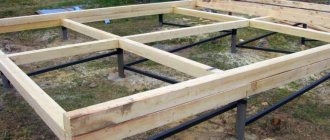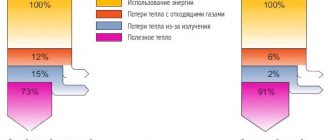November 13, 2016 Stroyexpert Home page » Foundation » Calculation
Modern housing construction of various scales and directions (industrial, civil, commercial) has a large selection of technologies used at various stages of construction. The choice of the optimal option is carried out by designers and property owners at the stage of developing project documentation. One of the most popular ways of arranging a foundation is laying a pile field.
Why is a pile field constructed?
The pile field is one of the most important components of any pile foundation. After the work of tying a grillage around separately placed piles, its purpose is to serve as a foundation for the construction of residential and industrial buildings, engineering and hydraulic structures.
In the pile foundation of each house, piles with a grillage play completely different roles. By means of a grillage, the piles are combined into a single monolith, this gives them additional stability and increases resistance to buoyancy and horizontal forces. In this case, each pile is evenly loaded with the load from the building.
Each of the elements of the pile field transfers the load from the house to the volume of soil in which their supporting part is placed. With significant deepening of the piles (3-15 m), the surface of the soil is opened and the load from the weight of the house is distributed in already stable and high-density soil, which is of particular importance during construction in areas with unstable soils.
The construction of the house should be carried out after the completion of tying the pile field with a grillage, which serves as a supporting structure for the masonry of walls.
Nuances of building houses
As a rule, reinforced concrete piles with high load-bearing capacity are used for the construction of brick houses and structures with concrete walls of several floors.
Screw rods and reinforced concrete supports of smaller diameter are effective when laying foundations for:
- frame,
- panel boards,
- wooden and other lightweight cottages.
Wooden driven piles have limited load-bearing capacity and are therefore used only for the construction of wooden structures.
Private houses and cottages on stilts are raised above ground level by at least 20 cm to eliminate the possibility of the structure overturning as a result of the action of heaving forces on the foundation.
Types of placement of supports in the pile grillage
Pile field
Depending on the geometric shape of the grillage and the design load from the structural elements of the structure, an as-built diagram is drawn up, according to which the piles can be placed in the following ways:
- In the form of a pile bush, that is, the combination of several compactly placed piles into a single structure. In this case, the ratio of the sides of the grillage should not exceed 1:5. This method of placement is used for racks, columns, as well as some types of structures of significant height (for example, chimneys).
- Pile strip - under elongated foundations of considerable length, for example, embankments.
- In a pile field, which differs from a bush in that its structure involves combining a larger number of piles, for example, when building a house on a solid grillage.
Minimum and maximum value between supports
According to SNiP requirements, the minimum distance between two adjacent screw piles is double the diameter of the blades. That is, if there are supports with 30 cm blades, the minimum distance between them will be 60 cm.
It is necessary to take into account that this is the distance between the blades, that is, when marking, marking the axes of the piles, one should consider not 2, but 3 diameters. The maximum distance is determined by the ratio of the weight of the house to the number of piles.
It is necessary to take into account the material and cross-section of the grillage so as not to cause excessive movement of the beams in the central part of each span . According to all calculations, the maximum is always determined as 3, in some cases - 3.5 m.
It is impossible to go beyond these values, this will create a threat to the structures of the house.
Construction of a pile field
Plan of a pile field
The builder's dictionary gives such an explanation of the term as follows: a rectangular platform on which the supports are immersed according to an established plan along a predetermined grid.
In a pile field, the supports of the structure being erected can be located either in rows or in a checkerboard pattern. The piles are deepened so that the distance of the outer design edge of the grillage from the pile axes is equal to the diameter of the support in plan.
How to choose the right step?
The distance between adjacent power elements is calculated based on the number of piles, as well as their diameters. To do this, first determine the design loads and analyze the design features.
In the case of a single and strip arrangement, the perimeter of the building is taken as a basis and divided by the number of piles . The result is compared with the minimum and maximum permissible parameters and, if necessary, the step is selected.
Errors in calculating the distance between supporting elements will lead to cost overruns, or to the risk of wall subsidence if the bearing capacity of the foundation in places with maximum load is insufficient.
Development of a pile field project
Before you begin to develop a project, draw up a plan and schedule for work, executive diagrams and the construction process itself, it is necessary to carry out a study of the soils located on the construction site. Determination of soil characteristics When performing research, the following is determined:
- Load-bearing characteristics of the soil;
- Soil water saturation;
- Soil density;
- Freezing depth;
- Geological section by soil types within the construction site.
The need to study the composition of the soil is due to the fact that it is not possible to determine the real bearing capacity of each support based on the material of its manufacture, since the value of soil resistance is often less than the bearing capacity of the support. It is for this reason that the characteristics of piles are determined by the characteristics of the soil into which they are buried.
Determination of soil bearing capacity
Determining the soil resistance to loads is one of the key stages when calculating the foundation, including finding the distance between supporting elements.
The main factors on which the bearing capacity of the soil depends:
- Breed type.
- The saturation of the earth with moisture.
- Characteristics of soil layers.
- Mass density
Oversaturation of the soil with moisture, which is influenced by the level of underground sources, reduces the bearing capacity of the soil several times. The moisture factor does not apply to areas where sand of medium and large coarseness is contained in predominant quantities. Maximum loads on the soil that will not lead to significant foundation settlements have been studied and listed in public reference books.
The data used by designers involved in engineering calculations for foundation construction is reflected in the table:
| Soil type | Load-bearing capacity, kg/cm2 | |
| average density | high density | |
| waterlogged clay | 4 | 4 |
| dry clay | 6,0 | 2,5 |
| loam | 3,0 | 2,0 |
| sandy loam | 3,0 | 2,5 |
| fine sand | 4,0 | 3,0 |
| medium sand | 5,0 | 4,0 |
| coarse sand | 6,0 | 5,0 |
| gravel | 4,0 | 3,0 |
| pebbles | 4,5 | 4,0 |
For construction on weak and waterlogged soil, a larger number of supports are chosen, as a result of which the distance between the load-bearing elements is reduced. You can find out the geological features of the site from the results of professional surveys carried out by specialized companies.
For private housing construction, you can determine the type of soil yourself. In this case, several wells are drilled or holes are dug to a depth of at least 2 m. From a section of the soil, it will become clear what rocks the soil is made of, at what depth the bearing layer is located, and also how moist the soil is.
Calculation of the required number of piles
Installation of piles
Determining the number of supports located in the pile field is carried out in several stages:
- Calculation of the total load on the base during its operation;
- Determination of the bearing capacity of each pile;
- Dividing the total load by the bearing capacity of the support, as a result of which the required number of piles is determined.
Upon completion of the calculations, an as-built diagram is drawn up, which reflects the placement of supports along the perimeter and internal walls of the house. To calculate the total load, the total mass of the building must be determined, taking into account the specific gravity of the building materials used, as well as the area of the structural elements of the house.
Then the operational load on the building is calculated; according to GOST 20107-85 it is equal to:
- For industrial buildings 200 kg/m2 of flooring;
- For residential buildings – 150 kg/m2.
When drawing up a project for a pile field for buildings with two floors, operational loads are calculated taking into account both floors.
At the next stage, calculations of snow load in winter are performed; its value is calculated depending on the region of construction. To do this, the roof area is multiplied by the standard weight of the snow layer per 1 m2.
The resulting loads are summed up and multiplied by 1.2 (reliability factor). At the next stage, the bearing capacity of the supports is calculated based on data on the main characteristics of the soil. After the calculations are completed, the total value of the loads is divided by the load-bearing capacity of the pile, resulting in the required number of supports, which is reflected in the as-built diagram, drawings and house plan.
Selection of pile type
Square piles
The most commonly used type of supports when constructing pile foundations for residential buildings are solid structures with a cross-section of 300x300 mm. Such piles are also used in construction:
- Low- and high-rise buildings;
- Industrial buildings;
- Devices for strengthening previously erected pile foundations.
When constructing buildings with a weighted structure, in which maximum load-bearing capacity is required from the supports, piles with a section of 350x350 mm and 400x400 mm can be used. When constructing a foundation for lightweight houses made of foam concrete and wooden materials, it is allowed to use supports 250 x 250 mm.
Square piles are widely used in the construction of buildings on all types of soil, in particular:
- On heaving soils;
- Soils on which horizontal shifts are possible;
- Moisture-saturated and low-density soils - peat bogs, muddy and wetlands.
To construct the foundation of a house in areas where the level of seismic activity is not higher than 6 points, hollow supports are used. Their cost is slightly lower than solid piles, which is due to some savings in concrete during production.
If the construction site has a layer of problematic soil of significant thickness (exceeding 10 cm), and the length of solid supports is not enough, then composite structures can be used. Their total length in some difficult cases can reach 28 m due to the joining of individual elements when immersed in the ground.
Optimal value
It is very difficult to clearly indicate the optimal distance between adjacent piles of a screw foundation. It is necessary to take into account a lot of specific factors specific only to a given site, building and other conditions of construction and operation.
However, there are certain limits that limit the minimum and maximum pitch between screw supports. Logically, the optimal distance should be the average value, but in reality the situation looks somewhat different.
Based on the results of experiments and practical tests, it was found that the optimal distance is 2 m . This value is suitable for almost all types and sizes of piles used in individual construction.
The optimal value should not be used as some kind of universal number that is suitable in any case. Each project must be calculated individually.
Performing markup
Carrying out marking work when constructing a pile field is one of the most important stages of preliminary work before deepening the supports. This process is divided into three stages:
- Bringing out the base lines of the pile field (foundation contours) to the construction site from the as-built diagram;
- Marking of driving points for each of the field elements according to design drawings;
- Determination of the zero line of the pile field, that is, the mark along which the supports are aligned after immersion in the ground.
Watch the video on how to properly mark the area for piles.
The marking is made using cast-off boards, between which a wire or rope is stretched so that the intersection points of the individual lead lines coincide exactly with the axis of the pile being driven in according to the as-built diagram.
When carrying out work, a “Certificate of Axes Layout” is drawn up, which is one of the most important documents for the construction of the foundation; as-built drawings and necessary diagrams are attached to it, and full information about the intervals between supports, the position of the lines and the height marks of each pile is indicated.
Base finishing
The outer part of the foundation protruding above the soil level is the base.
To complete the foundation, it is worth mentioning the finishing of the base:
- thermal insulation will keep the basement warm even in the harshest winter; for this, mineral wool or rigid polystyrene boards are used;
- waterproofing is especially important in low places with high humidity, marshy soil and the risk of flooding; the easiest way is to use coating waterproofing;
- decorative finishing, expanded clay concrete plaster or sealing with decorative panels;
- the obligatory low tide on the base will not allow water to leak under the foundation.
A correctly selected option for finishing the base can give the house a unique flavor. Ensure long-term operation of the building. One of the simple and effective types of finishing is clay plaster, on which, using a stencil, you can create an imitation of masonry. With low monetary and labor costs, the plastered plinth turns out to be original and memorable.
Pros and cons of strip foundations with piles
When we talk about the general advantages of a pile foundation, regardless of the specific production technology, they are as follows:
- Simple design.
- Material consumption is lower than, for example, when using a strip foundation.
- Can be used on weak soils.
- Suitable for various buildings.
- Greater stability, good load tolerance, floor movement.
- Almost all work can be done independently and without the use of special equipment.
This is also an error:
- No matter how good the piles are, they also have load-bearing capacity. For particularly heavy buildings, a different type of foundation should be chosen.
- There is practically no way to arrange a basement.
- Difficulties in calculating the properties of the base. Online calculators that can be found on the Internet help partially solve this problem.
All about pouring the foundation
The best material for pouring is considered to be Portland cement M 200 - M 500.
The best material for pouring is considered to be Portland cement M 200 - M 500.
There are some rules for obtaining the highest results from these works. Their step-by-step implementation is encouraged:
- It is necessary to use cement of at least grade M 200;
- It is preferable to make a solution of medium density;
- Filling is performed with the shortest time interval for all wells;
- After its completion, reinforcement can be performed;
- It is better to first fill the load-bearing elements and leave them to dry for two days;
- After this, you can fill the grillage, also at the same time.
Nuances when performing work
When creating this type of foundation, the choice of technology plays a major role
When performing this work, the following nuances may appear, without which it will be impossible to fill:
- First, we fill the piles, and only then can we proceed to the area of the foundation made of strips;
- The fittings must be completely filled;
- The thickness of the solution should be of medium consistency;
It is prohibited to fill the foundation in wet weather, because the foundation will lose a percentage of its strength.
So, when creating this type of foundation, the choice of technology plays a major role. We do not recommend using the type of piles with filler; this can be allowed in a base made of tapes. Remember that only compliance with all construction standards and the correct composition of the mortar can build a strong and stable structure.
Tiled base
The most difficult arrangement of the foundation for a private house is to make a cut line for a tiled foundation. A monolithic slab is used when it is impossible to install other types. It fully compensates for all ground movements and minimizes the influence of seasonal floods and temperature changes. But this scheme has disadvantages - the complexity of the arrangement, the impossibility of creating a basement or basement floor. The work is carried out according to a pre-drawn plan - installation of utilities, preparation of the land plot.
Features of the formation of a cross-sectional drawing of the base slab of a private house:
- First, a wiring diagram for water supply and sewerage is drawn up. The pipes will pass through the slab base. Therefore, you need to choose in advance their location relative to the house plan.
- Site preparation. For the arrangement, it is necessary to make a shallow pit - up to 80 cm. It is recommended to install heat and waterproofing at the edges.
- The first layer is a cushion of crushed stone. It is laid on leveled and compacted soil. Thickness – 20-30 cm.
- The second is backfilling with sand. For better adhesion, it is treated with cement laitance.
- Then waterproofing and a layer of insulation are installed.
- Volumetric steel reinforcement. It is formed from steel rods welded together. The size of the cells is calculated in advance and depends on the area of the foundation slab and the weight of the building.
- Installation of sleeves for laying utility pipes.
- Pouring concrete. To remove air, you must use a construction vibrator.
The final hardening time depends on the thickness of the concrete slab and the climate. This usually happens in 40-60 days. It is important to draw a sectional drawing of the foundation in order to correctly calculate the load and location of the main elements.
To draw up a foundation diagram, you can use special programs. It should be part of the overall project for the construction of a country residential building. Therefore, it is recommended to purchase a comprehensive package of design documentation.











